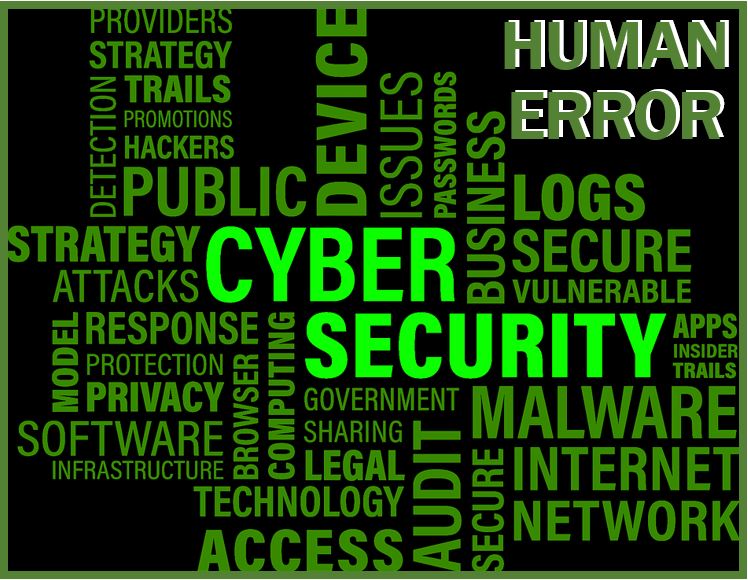We all make mistakes; it’s a part of life. Mistakes are how we learn and grow. But when it comes to cybersecurity, human mistakes are too often ignored. IBM researchers found out that human error causes 95% of data breaches. These costs add up to billions of dollars per year.
 Why do simple mistakes create so many problems for cybersecurity? And why haven’t existing solutions solved the problem already?
Why do simple mistakes create so many problems for cybersecurity? And why haven’t existing solutions solved the problem already?
Let’s dive into the role of human error in cybersecurity breaches along with steps you can take to create better digital security habits in your life.
How to Define Human Error in Cybersecurity
In the context of cybersecurity, human error has a different meaning. IT researchers define a human error as an unintentional action or a lack of needed action that ends up causing, spreading, or allowing data breaches to occur.
Human error includes a broad scope of action from downloading malware to using weak passwords. In fact, it’s so broad that it can be challenging to address the issue.
The number of digital tools in the work environment is only increasing. Each app, service, and account have usernames, passwords, and other sensitive information. It all adds up to create complexity in both work and personal environment. As a result, people start to take shortcuts or neglect some things to make their life easier.
And you can’t blame them. Criminals perpetrate cybersecurity threats. Hackers have a vast arsenal of tools from advanced malware and viruses to social engineering techniques to fool people. They can create an infinite number of risks for cybersecurity. And that results in an environment with considerable potential for data breaches.
Types of Human Error
IT experts categorize human error into two different categories: skill-based and decision-based. The difference boils down to whether a person has the required knowledge to perform specific actions.
 Skill-based errors
Skill-based errors
Skill-based errors are minor mistakes that happen when performing routine tasks. Think of them like typos. Users know what the correct actions are, but they have a temporary lapse of judgment or makes a mistake. They happen when people are exhausted, not paying attention, or are facing a challenge distracting them from what’s going on.
Decision-based errors
Decision-based errors occur when users make the wrong decision. Many factors may contribute to such errors. Most of the time, it’s a lack of necessary knowledge to perform specific tasks. Or they may not even realize they’re making a decision.
With either type of error, companies need to find ways to reduce them as much as possible.
Most Common Human Errors
There are endless types of errors that people can commit. But the most common are:
- Misdelivery. Delivering sensitive information to the wrong person. Such as providing company data to a hacker pretending to be an employee.
- Weak Passwords. Using short, simple passwords that hackers can crack in a matter of seconds.
- Not getting patches or vital updates. Missing critical patches that plug security vulnerabilities.
- Physical security. Leaving devices in insecure environments or without password protection.
How to Reduce Human Error
It’s impossible to end human errors. But you can reduce the occurrence and cut its damage when it does happen.
Businesses and individuals alike find it useful to practice digital hygiene. Digital hygiene is a set of best practices that promote cybersecurity in all environments. The focus falls on the following three areas.
Training
Everybody should receive basic training. There are countless online courses and tests people can take. They need to know the basics of cybersecurity, such as:
- Recognizing suspicious emails and websites
- Scanning files and links before downloading
- Using antivirus and antimalware software
- Securing their accounts with strong passwords
- Using encryption on data and internet connection
Reducing opportunities for data breach
Hackers, like other criminals, rely on easy targets. For thieves, a house full of expensive items and no security system in place is an easy target. For cybercriminals, it’s an unprotected or poorly protected digital business.
You can reduce opportunities for a data breach with:
- Privilege control. Users only need access to the data and functions necessary to do their job. It reduces exposure in the event of a data breach.
- Password management. It’s essential to use strong, unique passwords along with two-factor authentication. Storing all passwords in a password manager can make it convenient too.
- Data encryption. Using a file encryption service can often protect from the consequences of data breach altogether. And encrypting files is pretty easy too. You can download Nordlocker for Mac to add file encryption to your security portfolio already.
Changing the Culture
Focusing on security is the key. With every action, you need to consider safety. Everyone needs to be on the lookout for threats and feel comfortable discussing security issues. And for that, you need to foster a better culture.
- Encouraging discussion. Everybody should be aware of the latest security trends. They should feel free to discuss these with colleagues and be ready to hear about threats that may impact them.
- Making it easy to ask questions. It’s okay if you’re not an expert. But everybody should feel comfortable asking questions. If something doesn’t look safe, people need to be able to ask about it. It is the best way to prevent errors before they happen.
- Have monthly reminders and discussions. A little bit of time refreshing everyone about cybersecurity can go a long way.
- Be comfortable sharing mistakes. The sooner an error is caught, the less damage it can do. Anybody can make a mistake, and they need to feel comfortable sharing it asap.
Make People Your Strong Asset
Humans don’t need to be the weakest link. The best thing about digital hygiene techniques is they’re easy for people to learn. From here, they can apply them not only to their work lives but to the personal ones as well. That creates a comprehensive security everybody needs to prevent cyber-attacks.
_______________________________________________________
Interesting related articles:

